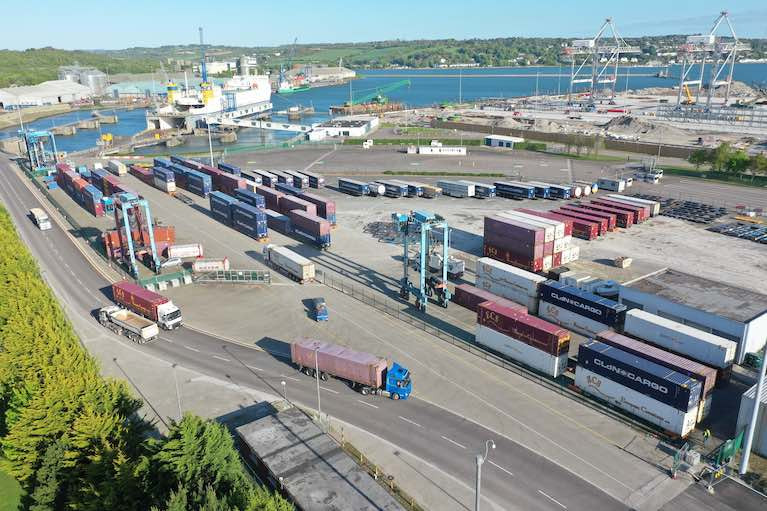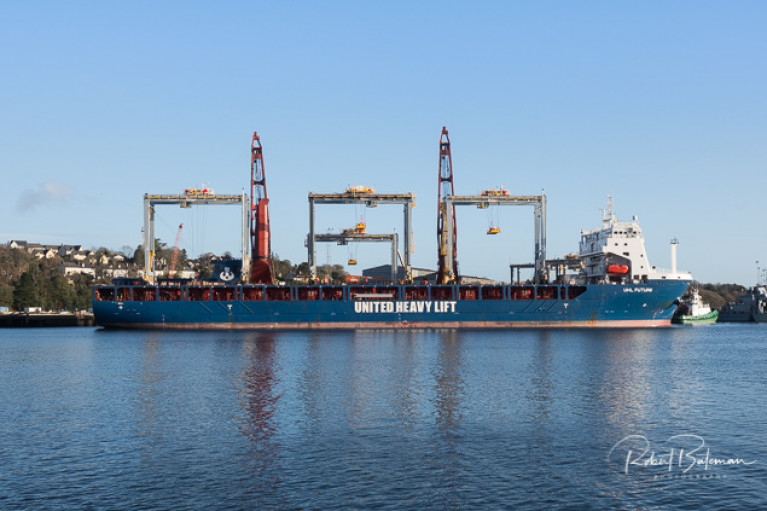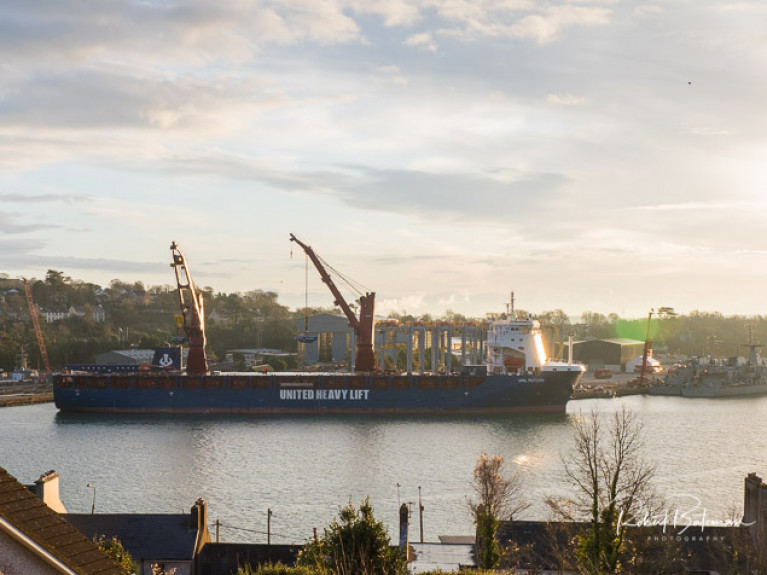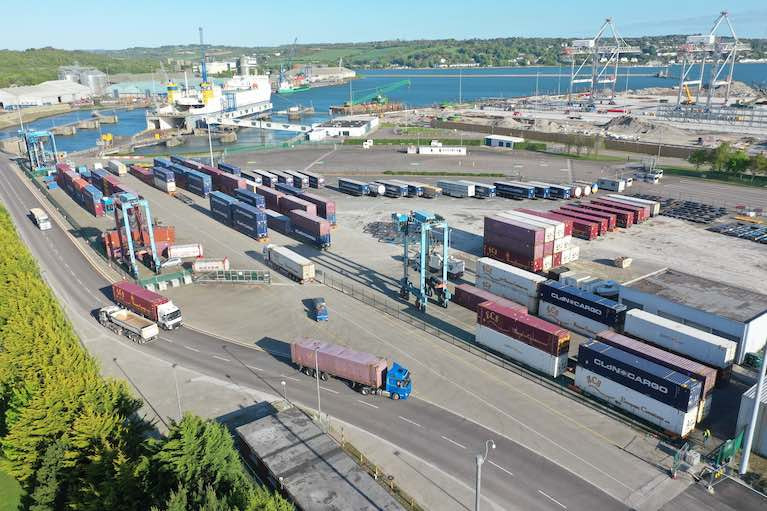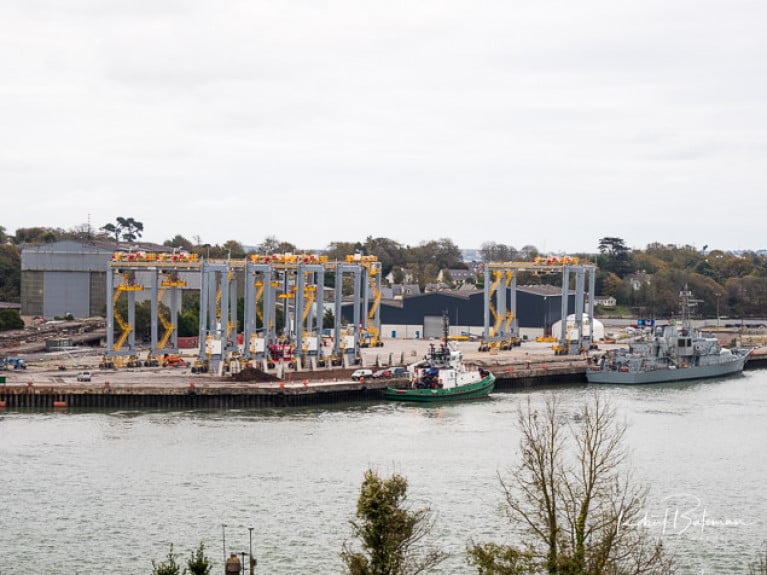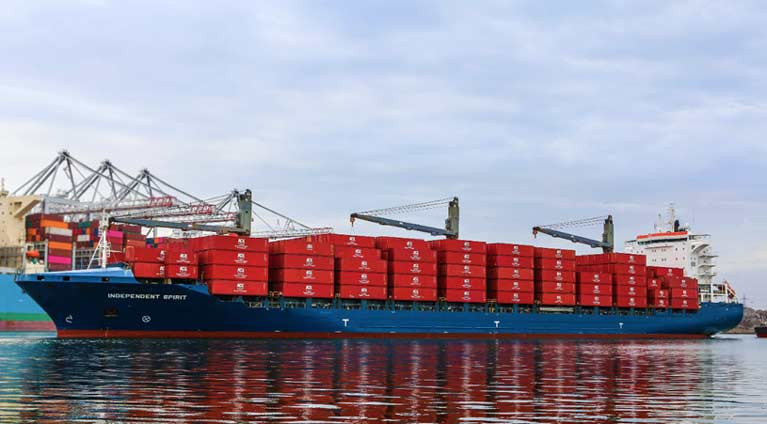Displaying items by tag: port of Cork
Following a strong start to CLdN’s weekly Con-Ro service from Cork to Zeebrugge, the shipping line announced a second call to accommodate demand. This second direct service from Cork to the EU commenced today, offering more flexibility to Irish customers, ensuring supply chains are maintained.
Considering Brexit and combined with the modal shift from accompanied to unaccompanied shipping, having a second direct link between Cork and Zeebrugge will bypass the UK Landbridge. For importers and exporters, this means avoiding unnecessary border checks thus ensuring cargo flows more effectively and in a cost-efficient manner from Ireland direct to the continent.
According to CLdN, over the last months, there has been steady growth in customer demand for reliable, low cost and Brexit-proof unaccompanied freight products. Shipping unaccompanied trailers, (tank) containers, finished vehicles or project cargo between its own ferry terminals provides a ‘one-stop shop’ for customers to get goods shipped across the North Sea without running the risk of disruption.
A spokesperson for the Port of Cork said: ‘Recently we have seen the spotlight on Ro-Ro freight since Brexit came into force, however, CLdN have seen a shift to unaccompanied freight, which is clearly popular among logistic companies and advantageous. The benefits of unaccompanied freight can bring a reduction in costs, greener freight movements as minimising the amount of time your drivers are on the road and greater flexibility depending on the type of cargo being shipped.’
A spokesperson from CLdN stated: ‘As we have shown and continue to deliver, we will deploy larger vessels or add more frequency to match demand to and from Ireland and will react immediately the market signals a requirement, as we see the Irish market as a core route in our portfolio'.
UHL Focus, the second of two heavy lift vessels has loaded four of eight RTG cranes in the Port of Cork for discharge in Berbera, Somaliland.
As Afloat reported earlier, the heavy-lift operations have been ongoing at Cork Dockyard in Cork Harbour this month when the first shipment was loaded on to UHL Future,
This week's second sister ship arrival will load the other half of the Liebherr cargo. The vessel, a General Cargo Ship was built in 2019 and is sailing under the flag of Madeira.
As regular readers will recall, the consignment for Somaliland arrived at the Cork Docks in October.
Liebherr Cranes Loaded onto Heavy Lift Ship at Port of Cork
UHL Future, the first of two heavy lift vessels has loaded four of eight RTG cranes in the Port of Cork for discharge in Berbera, Somaliland.
As Afloat reported earlier, the heavy-lift operations have been ongoing at Cork Dockyard in Cork Harbour this week.
A second sister vessel will load the other half of the Liebherr cargo next week.
As regular readers will recall, the consignment for Somaliland arrived at the Cork Docks in October.
Heavy lift operations are planned at Cork Dockyard in Cork Harbour today loading project cargo (Afloat understands to be Liebherr gantry cranes) onto the vessel ‘UHL Future’.
Operations will occur at multiple times per day, for periods of up to 2-3 hrs per lift & planned to be completed within five days.
UHL Future is part of the German Unique Heavy Lift fleet based in Hamburg. The ship is almost brand new, built in 2019 and sailing under the flag of Portugal.
It’s carrying capacity is 14058 t DWT and her current draught is reported to be 6.7 metres. Her length overall (LOA) is 149.97 meters and her width is 25.9 metres.
See UHL Future slideshow below by Bob Bateman
Port of Cork & CLdN Announce Second Call from Cork to Zeebrugge
The Port of Cork has welcomed CLdN’s decision to add a second weekly call from Cork to Zeebrugge to cope with the increasing demand on the current route. Adding a second call will offer CLdN customers a quicker turnaround, as well as bypassing the UK land bridge and avoiding unnecessary border checks, ensuring cargo flows more effectively and in a cost-efficient manner from Ireland direct to the continent.
The Cork to Zeebrugge Ro-Con service which started in May, as Afloat reported here, has been very popular with customers, who now welcome the second service offering them even more flexibility.
Conor Mowlds, Port of Cork Chief Commercial Officer said: ‘This is very exciting news for Cork and indeed importers and exporters utilising the current service. Added frequency offers flexibility and with more and more cargo looking to avoid the UK land bridge, this second Cork to Zeebrugge service is another step forward in ensuring supply chains are maintained.’
 The cargo supply vessel Evita moored in Cork Harbour this week. The Port of Cork is Ireland’s primary southern gateway Photo: Bob Bateman
The cargo supply vessel Evita moored in Cork Harbour this week. The Port of Cork is Ireland’s primary southern gateway Photo: Bob Bateman
He continued: ‘In these extraordinary times a second direct Ro-Con freight link with Europe from Cork, Ireland’s primary southern gateway reinforces our commitment to supporting businesses in the region and preparing for any eventuality Brexit may bring.’
A spokesperson from CLdN stated: ‘As we have shown and continue to deliver, we will deploy larger vessels or add more frequency to match demand to and from Ireland and will react immediately the market signals a requirement, as we see the Irish market as a core route in our portfolio.’
Busy Port of Cork as 'Independent Quest' Arrives from America & Liebherr Ship Cranes to Somaliland
There are busy scenes at the Port of Cork this week where Liebherr cranes are being assembled before shipment at Cork Dockyard later this month.
Eight Liebherr 'Ready to Go' (RTGs) have been assembled and are being finalised for sea transport to DPWorld Somaliland, according to social media posts by Liebherr Maritime Ltd.
On Saturday, (17th October 2020) Cork Harbour also welcomed Independent Quest, her maiden visit to Cork as part of the new Trans Atlantic-Ireland shipping route.
 Progress continues on the development of the new Port of Cork terminal with the two new Liebherr post-Panamax size ship-to-shore (STS) container gantry cranes (left) and Pont Aven ferry in berth (right) Photo: Bob Bateman.
Progress continues on the development of the new Port of Cork terminal with the two new Liebherr post-Panamax size ship-to-shore (STS) container gantry cranes (left) and Pont Aven ferry in berth (right) Photo: Bob Bateman.
As Afloat reported previously, progress also continues apace at the new Port of Cork Container terminal in Ringaskiddy with the new giant gantry cranes at work, a clear sign of headway at the Terminal. The cranes improve liners’ schedule reliability and reduce trade costs, and inventory holding outlays for shippers.
The Port is investing €80 million in the new terminal It offers a 360-metre quay with 13-metre depth alongside and enables larger ships to berth in the port.
 Pont Aven ferry (left) and Independent Quest cargo ship (right) safely docked after passage from USA Photo: Bob Bateman
Pont Aven ferry (left) and Independent Quest cargo ship (right) safely docked after passage from USA Photo: Bob Bateman
Impressive New Port of Cork Liebherr Cranes on the Cork Harbour Skyline
The two new Liebherr post-Panamax size ship-to-shore (STS) container gantry cranes make an impressive sight cutting the Cork Harbour skyline at the Cork Container Terminal (CCT) in the Republic of Ireland.
Port of Cork took delivery of the gantry cranes at the terminal in February this year and they were assembled on-site as Afloat reported here.
The cranes improve liners’ schedule reliability and reduce trade costs and inventory holding outlays for shippers.
 The post-Panamax Port of Cork Cranes Photo: Bob Bateman
The post-Panamax Port of Cork Cranes Photo: Bob Bateman
More Liebherr cranes are currently being assembled at Cork Dockyard in the harbour as Afloat reports here.
Construction on CCT began in June 2019 and will finish in 2020. The €80m project will initially offer a 360-metre-long quay with a 13-metre depth alongside.
The Cork Harbour development also includes the construction of a 13.5-hectare terminal and associated buildings.
Port of Cork Company Appoints New Chief Executive, Eoin McGettigan
The Port of Cork Company has appointed Eoin McGettigan to the role of Chief Executive of the company. Eoin replaces Brendan Keating who retired recently after 18 years of service as CEO.
The Chairman of the Port of Cork Company, John Mullins stated that ‘Brendan Keating made an outstanding contribution to the Port as Chief Executive since 2002. Brendan has seen the Port’s Strategic Development Plan fully recognised: the acquisition of Belvelly Port Facility (formerly Marino Point), the Inner Harbour Development at Bantry Bay Port Company, the marked increase in cruise business and the commencement of construction of the €86 million Cork Container Terminal in Ringaskiddy which will future proof the port. I have no doubt that Eoin will now take these projects and the business forward to further enable our growing economy.’
Eoin has spent the last decade providing strategic advice to a wide variety of companies. He has thirty years’ experience as a Senior Executive in Retail, Wholesale and Property businesses. He has held senior board positions in Musgrave PLC as Chief Executive of Supervalu Centra, Director of Dunnes Stores and Director of Reox Holdings PLC. Eoin and his family have lived in Cork for over 30 years.
John Mullins said: ‘Eoin brings with him a wealth of Senior Executive experience, excellent leadership skills and an integral knowledge of modern supply chains and logistics. He joins the Port at a strategic and exciting time for the company and the Southern region. The board and all in the Port company wish him every success.’
He added “Eoin will steward the company from the River to the Sea through the commissioning of key infrastructure in the lower harbour whilst making available former assets for critical residential and commercial development. Eoin’s property experience will be instrumental in ensuring that Tivoli will be one of the most exciting projects in the future for the company and for the City of Cork.’
Eoin McGettigan takes up the position as Chief Executive on 1st October 2020 for a term of five years.
Cork Harbour's Impressive Slipway & Marine Facilties at Paddy's Point in Ringaskiddy
As Afloat reported in July, the new public recreation area at Paddy's Point in Cork Harbour now has a new floating pontoon added to the existing marine leisure facilities at Ringaskiddy.
As it turns out, the new facilities were about to be put to championship use in August to handle a fleet at the Laser National Championships until the event had to be cancelled by Royal Cork Yacht Club due to COVID concerns.
The pier and slipway, that opened in May 2019 is located adjacent to the Beaufort Building in Ringaskiddy and is managed and maintained by the Port of Cork.
The substantial new facilities replace the existing Ringaskiddy slipway and pier and were completed as part of the Cork container terminal development.
 This new marine leisure facility is free for the public to use and includes a pontoon to launch leisure craft Photo: Bob Bateman
This new marine leisure facility is free for the public to use and includes a pontoon to launch leisure craft Photo: Bob Bateman
These latest photos of Paddy's Point further illustrate what a fine structure is now in situ and what a welcome addition it is to Cork Harbour's marine infrastructure.
The Port of Cork has announced the start of a new weekly direct service from Cork to USA, giving Ireland its first direct container service to the USA in many years.
The new Cork Harbour service is set to commence with the sailing of the ‘Independent Vision’ on June 6th. ICL will sail from the Port of Cork every Saturday arriving on the East Coast of the USA 10 days later, offering Irish exporters the most reliable and fastest delivery times for their supply chains.
CEO of the Port of Cork, Brendan Keating said: ‘The Port of Cork is delighted with this opportunity to work with ICL and support this new direct route to the US. The timing is perfect with the opening of our new €80 million Cork Container Terminal in Ringaskiddy on the horizon and has the potential to grow cargo volumes from and to Ireland. This is a fantastic strategic development for the Port of Cork as we look to develop Ringaskiddy as a modern logistics hub.’
CEO of ICL John Kirkland said: “Ireland is a market we have been keen to develop for a while and we sincerely hope the Irish trade support this commitment by ICL, to bring Ireland its first direct weekly service to the USA East Coast. We look forward to working with the Port of Cork with their exciting expansion plans”
ICL has been serving the North Atlantic trade for 35 years and is consistently named the most reliable carrier.



























